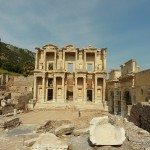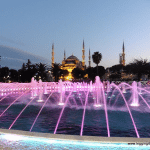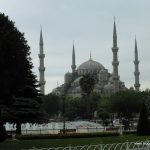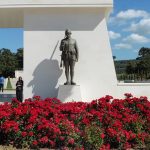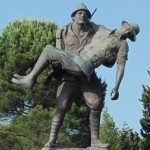Clouds blanketed the sky and a chilly breeze was blowing this morning when we woke up hoping to get our last glimpse of the balloons over Cappadocia. However due to the weather, their were no balloons. Today we head from Uçhisar to Konya on our way to Egirdir near the Pammakale lakes as we head east through Turkey.
The views from the verandah at Uçhisar Cave Pansion is just perfect, with views over pigeon valley below and across to Göreme.
We’ve really enjoyed the last few days in Uçhisar, eating at a few of the local restaurants and getting to know a few of the local Turkish characters. The family at Uçhisar Cave Passion have been so nice and welcoming. Sitting high on the hill below the Uçhisar Castle it’s a perfect location.
After packing the bike, we headed out through the Uçhisar market place with a few of the locals waving and wishing us safe journey. Then it was through Nevsehir and on towards Aksaray. The countryside is a patchwork blanket of greens and brown stretched over rolling hills. Patches of dark green amongst the washed out green indicated the use of irrigation sprinklers. Farmers were busy on their Turkfiat and New Holland tractors turning over the soil in anticipation of spring rains.The treeless hills and planes rolled all the way down to Aksaray. The cold overcast conditions were perfect for just opening up the throttle and enjoying the wide expansive scenery.
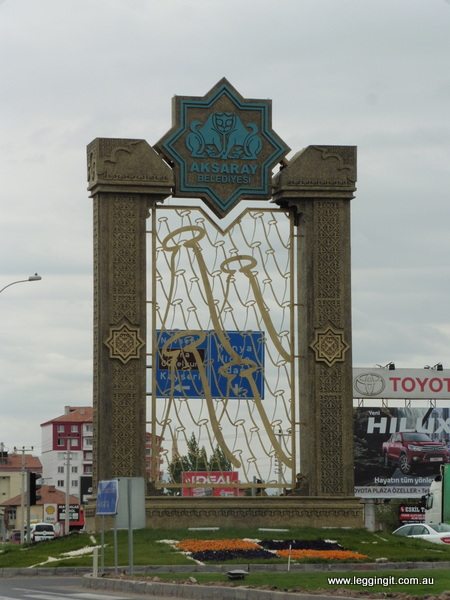
Arriving in Aksaray we stopped off for fuel and a coffee at a Maccas. Looking at the menu we were surprised that the prices are on par with Australia. We wondered how local Turks could afford to eat there. It could also explain why at 11 o’clock the place was almost empty.
Heading out on the road between Aksaray and Konya the land flattened out. It was real wheat country, and the only movement in the whole of the landscape was the occasional tractor ploughing fields.
The towns along the highway were all set back a little distance so there were no cafes or restaurants. There were a few fuel stops, and stopping points but no connection to the local population.
On the edge of Sultanhani and near Obruk we noticed a few tent cities of itinerant farm workers which was quite surprising.
Konya
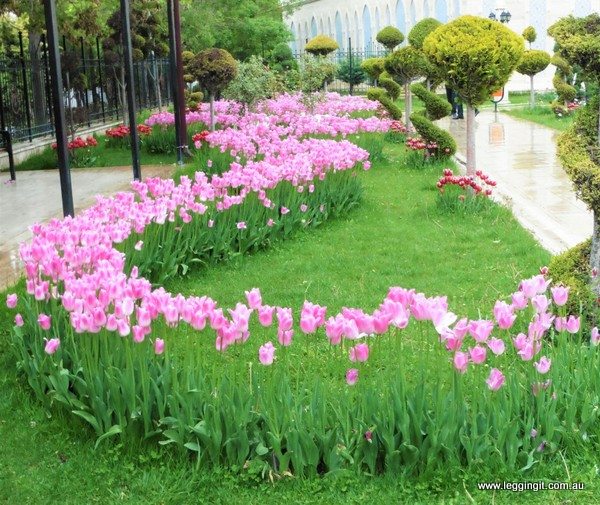
With the occasional rain sprinkle dogging us we finally reached Konya. Quite surprisingly Konya is a large rural city of about 1 .25 million people. Set in the heart of the wheat belt, apart from being a grain hub it also has a large manufacturing industry. Being the spiritual home of Sufism it’s also very conservative with most women wearing head scarfs and people quite religious. The Whirling Dervishes are a sect of Sufism also originated from here.
We arrived at the apartment situated over the top of Vav Steakhouse and met Burek, the former chef, who after living most of his life in Belgium spoke Flemish, French, Turkish and English. We had a great conversation whilst waiting for the room to be readied and he translated for us. We learnt a little bit about his life and his dreams. He also told us a little bit about Konya, and it’s people. It was a really nice encounter.
Mevlâna Cultural Centre and Museum
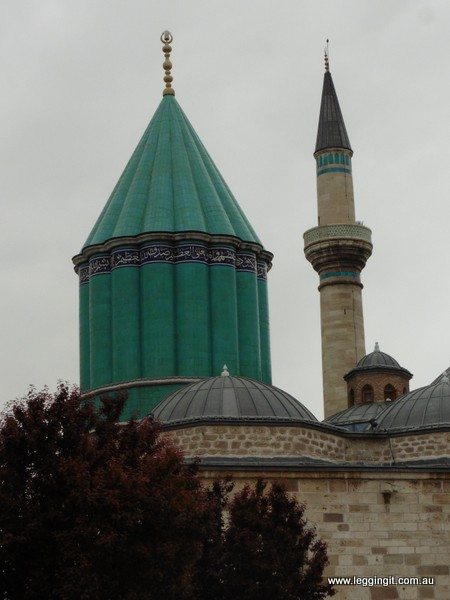
After checking into the apartment we headed into the city hoping to find the Mevlâna Cultural Centre and Museum. As Konya is the home of Dervishes, the Mevlâna Cultural Centre has a free whirling dervish show every Sunday night starting at 7 pm. Seeing we had arrived early we entered the Mevlâna Museum which also has free entry on sundays. The Mevlâna Museum is built around the Mevlâna Mosque and its outbuildings.
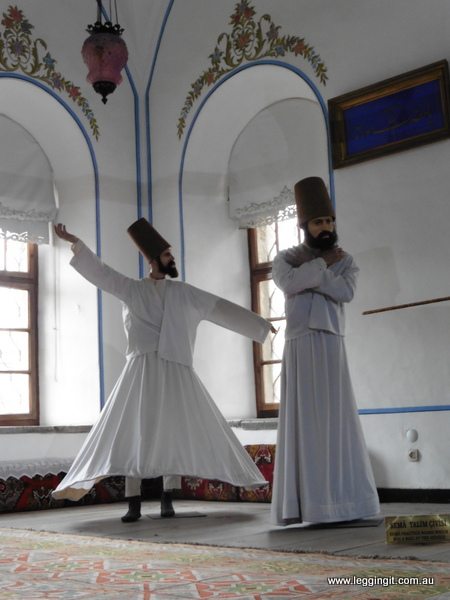
An L shaped building houses bits and pieces of the museums articles in each separate room, with explain actions in Turkish and English. There’s calligraphy, clothing, prayer rugs, quorans, and other items associated with religious life of monks.
The mosque is one of the most holy places for Sufi’s and there were quite large crowds with people from all over the world. Outside the mosque a large number of people were washing their feet face and hands in preparation for prayer at the covered purifying area.
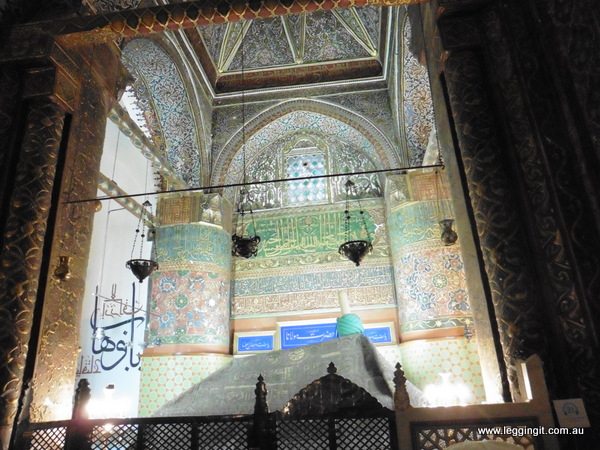
Entering the mosque a large number of stone tombs lined the edges of the main room. Ornate Arabic script design on the wall surrounds the tomb of Mevlâna, (Jalal al-Din Muhammad Rumi). In 1273 he founded the Sufi Mevlevi order (known for the Whirling Dervishes) and spent the last fifty years of his life here in Konya.
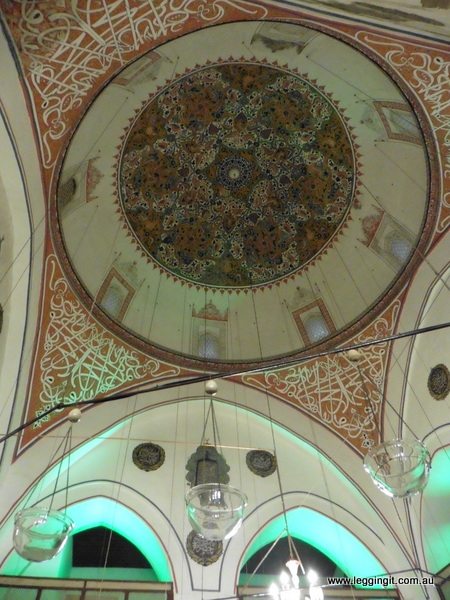
In the central area of the mosque a separate males and females section were segregated to allow people to continue to pray. Despite the signs asking people not to take photos of people in the prayer section there were some still snapping away. We’ve been to churches and temples all over the world and it seems some people just can’t respect other people’s privacy when praying.
Around the outside of the mosque are a few separate tombs and graves. There’s also cafe’s and a gift shop which were quite crowded.
As it was almost 6pm we headed towards the Mevlâna Cultural Centre about 600 metres away. With all the new buildings around it took us a while to work out which building it was but with a big bus station at the front and a huge stylised fountain we soon worked it out.
As we were early we noticed that there was a lecture about Mevlâna in the library so decided to take a look. A professor of philosophy greeted us and soon the library started filling up with locals, Pakistanis,and Australians (as there was another couple there). It was an interesting talk as we all sat around the table. The professor told us about the life of Mevlâna and the message of peace but we left still not knowing why the dervishes chose to whirl. We know its a form of prayer like the playing of the Nu (a bamboo flute) which was played for us.
Close to 7 pm we headed to the main auditorium and found a seat as it slowly filled up. After a fairly lengthy welcome in turkish (which sounded like a sermon) but allowed the last thousand people to arrive, the lights dimmed and the band entered the band pit. Led by the old mullah the dervishes dressed in dark blue capes and with a large felt hat slowly made their way out to the arena.
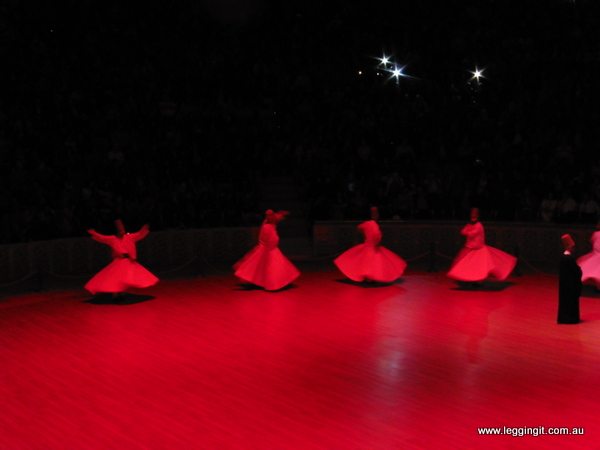
A vocalist started a fairly lengthy prayer song in a low tone slowly rising up and down through the tones as he sang. After the song the band played a hypnotic tune on their Nu, with the deep earthy tones of the wood resonating around the room. Then the dervishes took off their dark blue capes to reveal their long white robes over white pants and black boots. A simple ceremony involving about ten of them followed. Afterwards the music started again and the dervishes slowly filed towards the Mullah and after blessing slowly began to twirl. It was like watching a flower slowly open as their hands came from their sides up their bodies and out as they slowly rotated. Soon they were all spinning with their robes lifting off the ground to reveal their white trousers beneath as they slowly made their way around the arena. Each displayed their own personality with tilt of the head, angle of their arms and speed which they whirled. After each tune they would slowly unwind and group up into groups of twos and threes around the arena.
The music and the twirling was hypnotic and a few people were nodding off as each tune was quite long. By the start of the third tune the stands around the arena had started emptying out. Like Collingwood fans when the pies are down by six goals in the last quarter, people were filing out in their droves. By the mullahs final prayer the formerly packed stands were now half empty and as the dervishes started slowly filing off people were doing the same. It was an interesting experience and hoping to find the answers why the dervishes chose to whirl, well we didn’t. The only explanation I have is when we were talking to the professor about playing the Nu, he explained that it was a form of prayer where your love of Allah flows through the flute. The twirling is just another form of expression.
Battling the crowds to leave the auditorium we picked our way back to the bike in the dark streets, arriving to find a sticker left by We2R (an Austrian biker couple heading to Australia) We’d hoped to catch up with them as we were going different directions. We sent a message but as Konya doesn’t have a huge array of tourist attractions they’d moved on. With no satnav we picked our way back to the hotel in the one way series of streets which surround the centre, only passing the Mevlâna mosque twice.
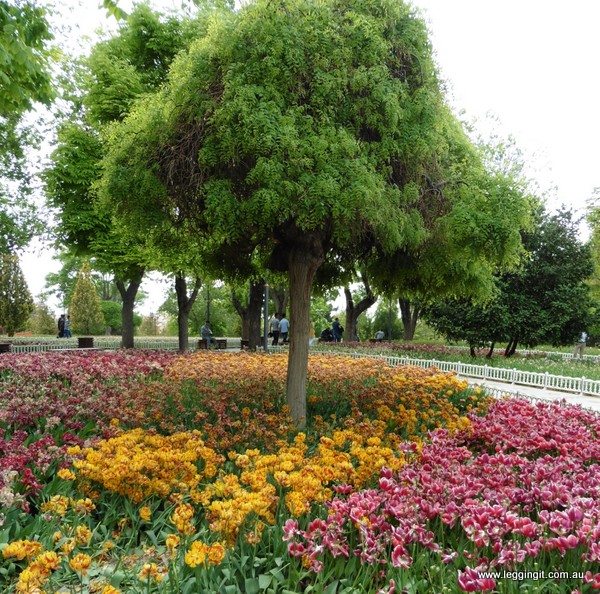
The next day we started out with a lovely Turkish breakfast at Vav before heading into the centre to Alaaden Park, a man made hill in the centre of the city. As it was Sunday lots of families were out enjoying the sun and the many cafe’s around the park were packed. After parking the bike we found a table amongst a heap of policemen. It seemed every table had a man in blue and they were all looking at us and the bike. We smiled, kept our heads down and ordered a çay.
Soon the policemen were summoned by the boss and they came running from everywhere to hear whatever he was saying. As they headed off some took a look at the bike but after a quick look they moved on and we relaxed.
We took a walk around the park to enjoy the gardens and the last of the tulips.
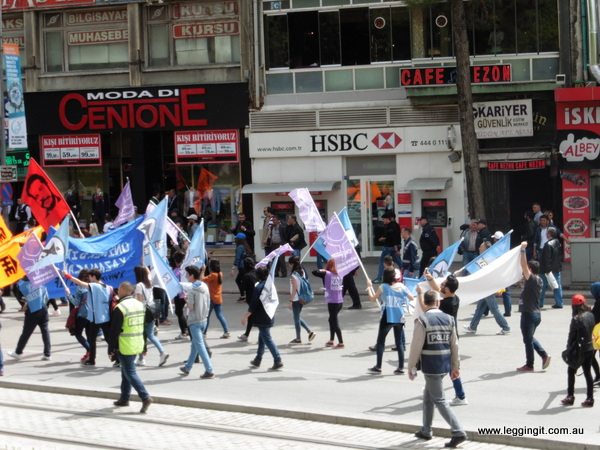
Loud music and people shouting attracted our attention and we soon discovered that the police were here in force to cover the May Day march. It was pretty intense with maybe two hundred marchers covered by almost equal numbers of police. A riot team and water cannon truck slowly dogged the parade whilst the uniformed police kept the marchers corralled on the street.
The rest of the day we spent riding around the streets enjoying the sun. Tomorrow we head to Ergidir on our transit west.

